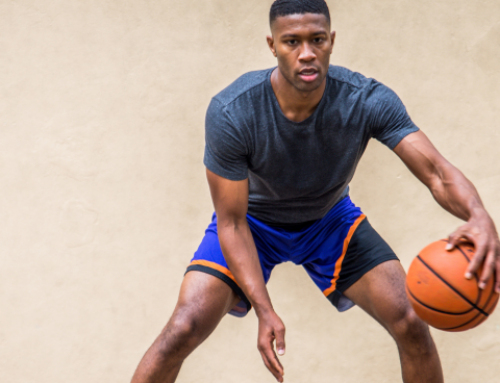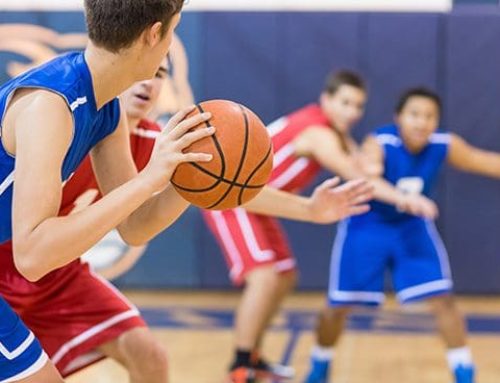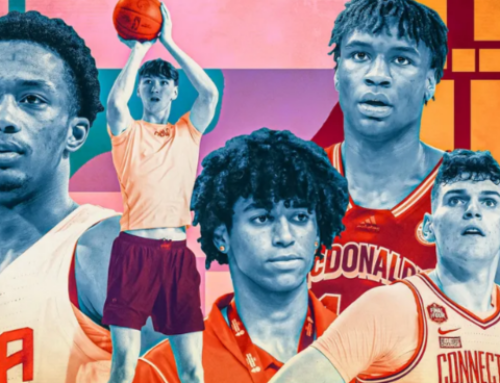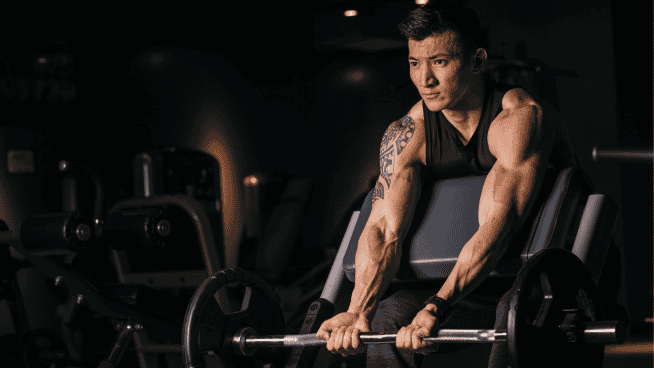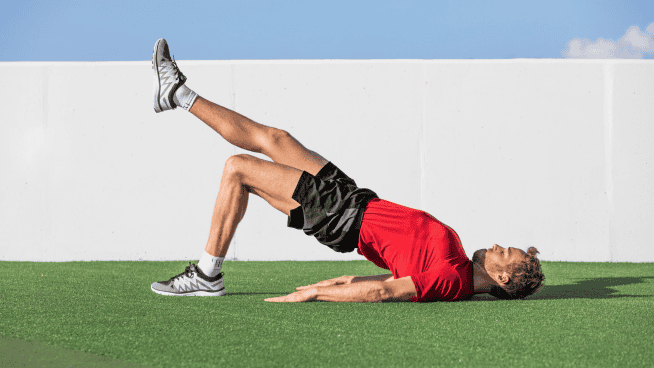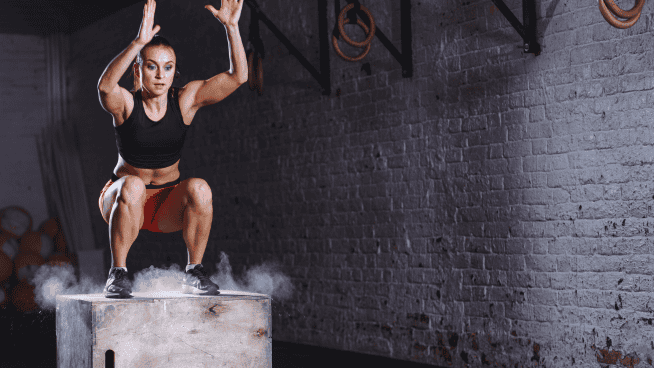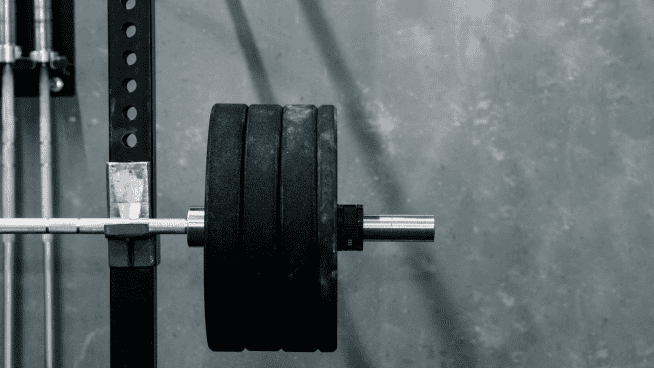Agility drills from basketball training experts
Stopping, starting, cutting, pivoting, changing direction—these are just a few elements of agility, but each one is as important to basketball as the rules that govern the game. To help any hoopster master the art of agility, we have some solid drills to up your skills from three regular STACK contributors.
STACK EXPERT 1: TIM GROVER
AGILITY DRILL OF CHOICE: STADIUM STAIRS
Basketball players can benefit from and improve agility by running stadium stairs. Training the feet to take small steps rapidly and efficiently translates to better footwork and quicker direction changes. The overload from the stairs can produce results quickly.
STADIUM STAIRS
- Run every stair, then every other stair
- Run forward, backward, left and right
- Lead with right foot, then left
Choose two directions per training day and perform 3 reps for each direction. Use your walk down the stairs to recover between runs. Take 2 minutes rest between different directions. Perform 2-3 times a week.
STACK EXPERT 2: MARTIN ROONEY
AGILITY DRILLS OF CHOICE: SIDEWINDER AND LYING COBRA
You might be looking for some cool change of direction drills here, but my first choices for improved agility are lower and upper body strength and postural exercises. Although there are a lot of flashy drills out there, athletes must first work on fundamentals. Athletes who are weak for their weight cannot overcome their own inertia and, therefore, can’t be agile. If their posture is terrible, again their agility will be affected negatively by poor joint positions. In addition to squats, pull-ups and other classic lifts, all of our athletes work on hip abductors and upper back extensors on agility days.
SIDEWINDER
- With perfect posture of upper and lower body, place resistance bands around ankles
- Turn and drive heel outward to work hip abductor muscles
- Control movement of legs throughout exercise
- Perform walks in three directions
Laterally
Backward
Wobble walk (walk forward with wide stance and bend in knees)
Perform lateral walks twice to each side for 15 yards, backward walks twice for 15 yards and wobble walks twice for 25 yards. Perform before every agility session. Rest 1 minute after each walk.
LYING COBRA
- Lie on stomach with arms at 45 degrees to body and palms down
- Raise head and chest off ground
- Squeeze shoulder blades together
- Rotate thumbs to sky
Perform 3 sets of 6 reps with a five-second hold at the top of the motion. Rest 20 seconds after each drill. Perform twice a week during agility workouts.
STACK EXPERT 3: TIM ROBERTSON
AGILITY DRILLS OF CHOICE: FIGURE 8 AND 3-CONE AGILITY
The Figure 8 drill is excellent for acceleration, deceleration, change of direction and body control through movement. The goal of the 3-cone agility drill is to finish as quickly as possible. However, attention to the efficiency of movement is the number one priority. The athlete needs to learn to breakdown and transition into the counter-movement as efficiently as possible. For both drills, incorporate dribbling a basketball to make them sport-specific. Shuffling, carioca and backpedaling can be used as variations for movements between cones.
FIGURE 8
- Line up three cones in a straight line five yards apart
- Start to left of first cone, sprint to right of middle cone
- Loop around middle cone, sprint to left of first cone
- Repeat pattern to the far cone
- Repeat pattern twice to complete one rep
When approaching and rounding each cone, make sure to drop the hips and lower your center of gravity while breaking down. Minimize a decrease in speed during change of direction.
Perform 2 reps starting to the left and 2 reps starting to the right of the first cone. Take a 45-to 60-second rest between reps.
3-CONE AGILITY
- Line up three cones, each 5-7 yards apart
- Sprint to middle cone, breakdown, touch line
- Backpedal back to first cone
- Sprint to far cone, breakdown, touch line
- Backpedal back to first cone
Choose two different movement patterns for a training day (e.g., sprint up, backpedal back and bear crawl up, shuffle back).
Perform 2 reps for each pattern with a 20- to 30-second rest between reps.
The Experts Speak
We asked three experts to define agility and its relevance to basketball. Although all agreed upon its importance to the game, each had something unique to say.
NAME: TIM GROVER
Facility: ATTACK Athletics
Location: Chicago
Key basketball clients: Dwyane Wade, Michael Finley, Quentin Richardson
Agility is the ability to maintain balance while moving the feet quickly, and the ability to rapidly change direction. Agility is important in basketball because the game is fast and the direction changes constantly.
Although many young athletes focus on shooting, agility training will improve all aspects of one’s basketball game. Maintaining balance and changing direction quickly will allow the athlete to get to the ball more quickly and be in better position to receive passes or attempt a steal.
NAME: MARTIN ROONEY
Facility: Parisi Speed School
Location: Fairlawn, N.J.
Key basketball clients: Adrienne Johnson and Tahira Williams of the WNBA
Simply put, basketball requires either creating separation or closing distance on the opponent. Although a lot of emphasis is placed on sport-specific skill development for young athletes, like dribbling and shooting, without the relative body strength and motor programs that make a basketball player agile, success will be limited.
My advice is that agility training is critical to sport success. Many young athletes want to do all the fancy extra stuff before ever really building the base. I promise that if you build your base correctly, your hard work will never betray you. So instead of just running through drills, make sure you are super strong and do the drills perfectly.
NAME: TIM ROBERTSON
Facility: Speed Strength Systems
Location: Cleveland
Key basketball clients: LeBron James, Nene, J.R. Bremer
Basketball is a stop-and-go sport that involves multidirectional movements. Often you have to get around opponents or teammates, with or without the ball, on offense or defense, to play the game. If you have good agility, which is balance and control of the body, you’re going to be more effective. Having all those parameters is going to make you better. These little intangibles make the players the players. Anybody can go out and shoot and shoot and be offensive-minded, but what separates the good players from other athletes is being a total player with agility. The game is more than just going out and playing. The game has evolved into working many different training techniques, and agility is a big component of that.
RECOMMENDED FOR YOU
MOST POPULAR
Agility drills from basketball training experts
Stopping, starting, cutting, pivoting, changing direction—these are just a few elements of agility, but each one is as important to basketball as the rules that govern the game. To help any hoopster master the art of agility, we have some solid drills to up your skills from three regular STACK contributors.
STACK EXPERT 1: TIM GROVER
AGILITY DRILL OF CHOICE: STADIUM STAIRS
Basketball players can benefit from and improve agility by running stadium stairs. Training the feet to take small steps rapidly and efficiently translates to better footwork and quicker direction changes. The overload from the stairs can produce results quickly.
STADIUM STAIRS
- Run every stair, then every other stair
- Run forward, backward, left and right
- Lead with right foot, then left
Choose two directions per training day and perform 3 reps for each direction. Use your walk down the stairs to recover between runs. Take 2 minutes rest between different directions. Perform 2-3 times a week.
STACK EXPERT 2: MARTIN ROONEY
AGILITY DRILLS OF CHOICE: SIDEWINDER AND LYING COBRA
You might be looking for some cool change of direction drills here, but my first choices for improved agility are lower and upper body strength and postural exercises. Although there are a lot of flashy drills out there, athletes must first work on fundamentals. Athletes who are weak for their weight cannot overcome their own inertia and, therefore, can’t be agile. If their posture is terrible, again their agility will be affected negatively by poor joint positions. In addition to squats, pull-ups and other classic lifts, all of our athletes work on hip abductors and upper back extensors on agility days.
SIDEWINDER
- With perfect posture of upper and lower body, place resistance bands around ankles
- Turn and drive heel outward to work hip abductor muscles
- Control movement of legs throughout exercise
- Perform walks in three directions
Laterally
Backward
Wobble walk (walk forward with wide stance and bend in knees)
Perform lateral walks twice to each side for 15 yards, backward walks twice for 15 yards and wobble walks twice for 25 yards. Perform before every agility session. Rest 1 minute after each walk.
LYING COBRA
- Lie on stomach with arms at 45 degrees to body and palms down
- Raise head and chest off ground
- Squeeze shoulder blades together
- Rotate thumbs to sky
Perform 3 sets of 6 reps with a five-second hold at the top of the motion. Rest 20 seconds after each drill. Perform twice a week during agility workouts.
STACK EXPERT 3: TIM ROBERTSON
AGILITY DRILLS OF CHOICE: FIGURE 8 AND 3-CONE AGILITY
The Figure 8 drill is excellent for acceleration, deceleration, change of direction and body control through movement. The goal of the 3-cone agility drill is to finish as quickly as possible. However, attention to the efficiency of movement is the number one priority. The athlete needs to learn to breakdown and transition into the counter-movement as efficiently as possible. For both drills, incorporate dribbling a basketball to make them sport-specific. Shuffling, carioca and backpedaling can be used as variations for movements between cones.
FIGURE 8
- Line up three cones in a straight line five yards apart
- Start to left of first cone, sprint to right of middle cone
- Loop around middle cone, sprint to left of first cone
- Repeat pattern to the far cone
- Repeat pattern twice to complete one rep
When approaching and rounding each cone, make sure to drop the hips and lower your center of gravity while breaking down. Minimize a decrease in speed during change of direction.
Perform 2 reps starting to the left and 2 reps starting to the right of the first cone. Take a 45-to 60-second rest between reps.
3-CONE AGILITY
- Line up three cones, each 5-7 yards apart
- Sprint to middle cone, breakdown, touch line
- Backpedal back to first cone
- Sprint to far cone, breakdown, touch line
- Backpedal back to first cone
Choose two different movement patterns for a training day (e.g., sprint up, backpedal back and bear crawl up, shuffle back).
Perform 2 reps for each pattern with a 20- to 30-second rest between reps.
The Experts Speak
We asked three experts to define agility and its relevance to basketball. Although all agreed upon its importance to the game, each had something unique to say.
NAME: TIM GROVER
Facility: ATTACK Athletics
Location: Chicago
Key basketball clients: Dwyane Wade, Michael Finley, Quentin Richardson
Agility is the ability to maintain balance while moving the feet quickly, and the ability to rapidly change direction. Agility is important in basketball because the game is fast and the direction changes constantly.
Although many young athletes focus on shooting, agility training will improve all aspects of one’s basketball game. Maintaining balance and changing direction quickly will allow the athlete to get to the ball more quickly and be in better position to receive passes or attempt a steal.
NAME: MARTIN ROONEY
Facility: Parisi Speed School
Location: Fairlawn, N.J.
Key basketball clients: Adrienne Johnson and Tahira Williams of the WNBA
Simply put, basketball requires either creating separation or closing distance on the opponent. Although a lot of emphasis is placed on sport-specific skill development for young athletes, like dribbling and shooting, without the relative body strength and motor programs that make a basketball player agile, success will be limited.
My advice is that agility training is critical to sport success. Many young athletes want to do all the fancy extra stuff before ever really building the base. I promise that if you build your base correctly, your hard work will never betray you. So instead of just running through drills, make sure you are super strong and do the drills perfectly.
NAME: TIM ROBERTSON
Facility: Speed Strength Systems
Location: Cleveland
Key basketball clients: LeBron James, Nene, J.R. Bremer
Basketball is a stop-and-go sport that involves multidirectional movements. Often you have to get around opponents or teammates, with or without the ball, on offense or defense, to play the game. If you have good agility, which is balance and control of the body, you’re going to be more effective. Having all those parameters is going to make you better. These little intangibles make the players the players. Anybody can go out and shoot and shoot and be offensive-minded, but what separates the good players from other athletes is being a total player with agility. The game is more than just going out and playing. The game has evolved into working many different training techniques, and agility is a big component of that.


